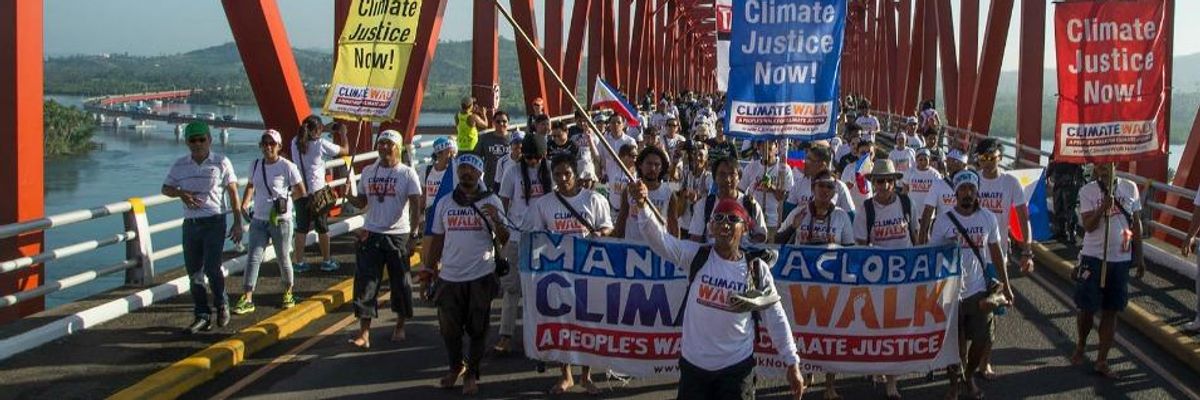The People's Climate Walk, a 40-day journey during which a core group of 14 activists traversed more than 600 miles to raise awareness about climate justice, ended Saturday in Tacloban City, where typhoon Haiyan made landfall exactly one year ago.
Supported by Greenpeace, Oxfam, and the Climate Action Network, the walk was both a call to action and a demonstration of solidarity with frontline communities, especially the millions of survivors of Haiyan, which killed more than 7,000 people and displaced 4 million people, many of whom are still living in temporary shelters. The walkers, whose ranks swelled to as many as 3,000 at points along the route from the capital city of Manila to Tacloban, traveled an average of 15-20 miles a day. They slept in places where evacuees slept during the disaster--churches, schools, covered courts--and organized with members of local communities.
Naderev 'Yeb' Sano, a leader of the walk, said such grassroots energy would have a lasting impact.
"At the least, every person whom we have encountered we can safely say we have converted on climate change action and they will become local environmental heroes in their own communities," he told Agence France-Presse. "Many of them promised to us they would continue the fight by organizing with their own communities to protect their natural resources."
Next month, Sano will attend the United Nations Framework Convention on Climate Change in Lima, Peru. Last year, he gained attention for his emotional appeal to world leaders at the UN Climate Talks in Warsaw, Poland.
"To anyone who continues to deny the reality that is climate change, I dare you to get off your ivory tower and away from the comfort of you armchair," Sano said at the time.
Upon reaching the Balyuan Convention Center in Tacloban on Saturday, the climate walkers were joined by at least 500 "students, environmentalists and members of civil society," InterAksyon.com reported. "They formed a human banner of the Philippine flag, symbolizing the growing national movement that is demanding climate justice, on behalf of the thousands who died in the disaster and the millions displaced by extreme weather events like [Haiyan]."
Without immediate action on global warming, such disasters will happen more frequently, writes Kristin Casper, legal counsel for campaigns and actions at Greenpeace International:
Tragically, such intense and destructive storms are likely to become more normal in the future as the climate crisis intensifies. Scientists have warned for decades that pumping greenhouse gases into the atmosphere has and will continue to cause the global average temperatures to rise and the result will be more and more extreme weather events.
As the world gets warmer, we should prepare for more intense typhoons and other harmful impacts of climate change. Communities like those affected by Haiyan are on the frontline of climate change and will be hit first and hardest.
The organisers of the People's Climate Walk, including Greenpeace Southeast Asia-Philippines, are supporting communities along the route to hold the big polluters legally and morally accountable.
Also on Saturday, thousands in Tacloban participated in a memorial march and vigil at dawn, and hundreds in Manila protested what they see as lack of government urgency or progress on reconstruction in the wake of the devastating typhoon.

